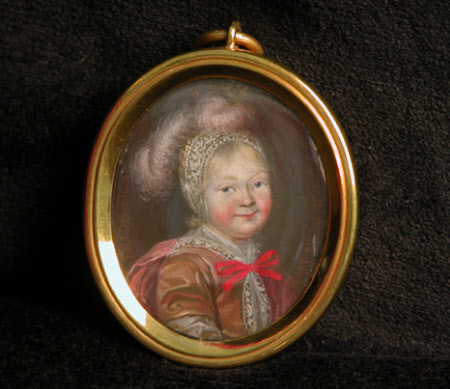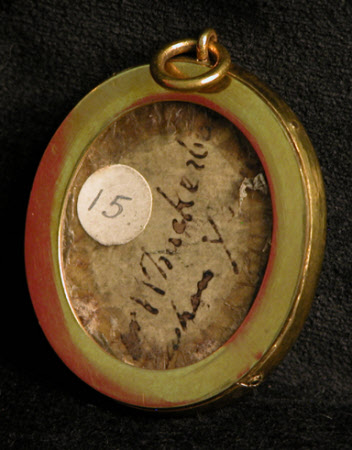Unknown Child ('Mr Whackerbach') (possibly King Frederick I, King of Sweden 1675-1751)
Dutch School
Category
Art / Miniatures
Date
Unknown
Materials
Copper
Measurements
44 x 38 mm
Order this imageCollection
Anglesey Abbey, Cambridgeshire
NT 515796
Summary
Portrait miniature, watercolour on vellum, Unknown Child ('Mr Whackerbach'), (possibly King Frederick I, King of Sweden 1675-1751). Dutch School. c.1700. Head and shoulders portrait of a young child, turned slightly to the right, gazing at the spectator, in a russet-coloured jacket, white lace steinkirk tied with a scarlet bow, white lace bonnet with a purple plume. Hazel eyes, fair hair, rosy complexion, chubby round smiling face. Inscribed on the vellum back 'Mr Whackerbach when Young' Probably a Dutch painting, artist unknown, c.1700. Catalogue entry 'Mr Wackerbach when young. A child's portrait, head and shoulders, wearing a cap with plumes and an elaborate dress'.
Full description
Portrait miniature, watercolour on vellum, Unknown Child ('Mr Whackerbach'), Dutch School. c.1700. This miniature is one of 28 displayed in an elaborate box with a sliding glass cover at Anglesey Abbey. The collection was sold at Sotheby’s on 9 May 1928 as lots 135–62, belonging to Mrs Tatton of Winwall Hall, Whitchurch, Hampshire. Mrs Tatton was described as a ‘lineal descendant of Paul Storr, of Storr & Mortimer, Old Bond Street, London, Court Jewellers to George III’. The miniatures were ‘said to have been formerly the property of King George IV.’ Unfortunately, there is no record in the Royal Archives of George IV ever having owned them. The collection was bought by Robson & Co for £600 for Huttleston Rogers Broughton, 1st Lord Fairhaven (1896–1966), and was bequeathed by him to the National Trust as part of Anglesey Abbey’s contents. Sitting among a clutch of dukes, earls, a marquis, a baron and miscellaneous titled ladies are two queens, four kings, a tsar and a prince, as well as two representations of George’s IV’s daughter, Princess Charlotte, and one of his mistress, ‘Perdita’ Robinson. There are also a small number of unidentified persons. And one misidentified one: ‘Mr Whackerbach when young’. What had not been noticed before the recent inventory photograph was taken by Sue James is that painted on the left-hand side is the word ‘Friderich’. Gareth Sandham, the Collections Manager at Anglesey Abbey, kindly examined the miniature more closely for me. This revealed that on the right-hand side there were what appeared to be the letters ‘HXJCVB’, followed by ‘AET 2½ 1678’. The next step was to search for a Friderich who was 2½ years old in 1678 and would have been important enough to be wearing the sort of clothing depicted in the miniature. It was intriguing to discover that King Frederick I of Sweden (1675–1751) was a possible candidate. Could the child in the miniature credibly be Frederick I of Sweden? Though Frederick is portrayed in a large number of the miniatures in the collection of the National Museum of Sweden, none actually shows him as a child. Strangely enough, however, the mature Frederick looks not dissimilar from the chubby, round-faced child in Anglesey Abbey’s miniature. Frederick I was the son of the Landgrave of Hesse-Cassel. In 1715 he married Princess Ulrika Eleonora of Sweden as his second wife. She became queen of Sweden three years after the marriage, and he became Prince Consort. Ulrika abdicated in 1720 and Frederick succeeded to the throne. After a promising beginning, he lost interest in affairs of state, took to the hunting field, and acquired a mistress by whom he had a number of children. His own marriage was childless. But we are still left with a mystery. Nothing is known about any Mr Whackerbach, but August Christoph von Wackerbarth (1662–1734) was a celebrated soldier who rose to be field-marshal in the service of Kings Augustus II and Augustus III of Saxony-Poland. Amongst the campaigns that he fought on behalf of Augustus II were two in Pomerania in 1711 and 1715. Western Pomerania had belonged, since the Peace of Westphalia in 1648, to the Swedes; in 1715 Wackerbarth besieged and took its key fortress, Stralsund. Could it be that this miniature was part of the booty, became a Wackerbarth heirloom, and thus gained a new—but false—identity? Is it indeed a miniature of Frederick I of Sweden? And what does HXJCVB mean? Derek Holdaway.
Provenance
Bequeathed to the National Trust by Huttleston Rogers Broughton, 1st Lord Fairhaven (1896-1966) with the house and the rest of the contents.
Makers and roles
Dutch School, miniaturist

